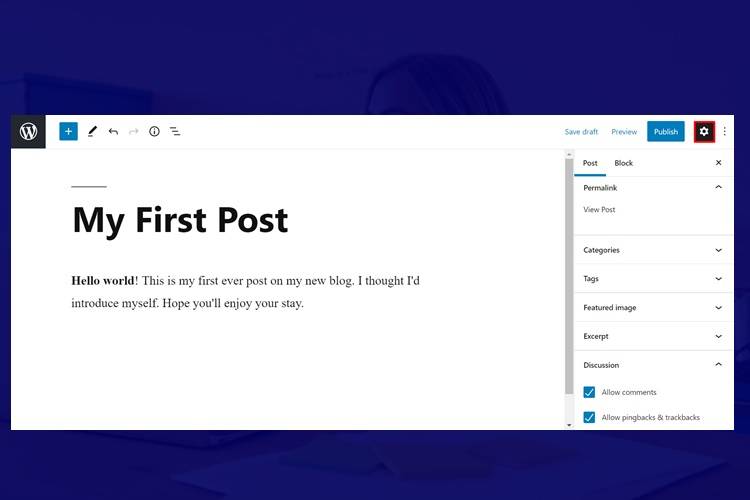For those who don’t already know, creating a website isn’t as hard as it was a decade ago. There are many modern platforms, known as content management systems (CMSs), for creating websites and blogs without writing a single line of code. Naturally, each solution on the market comes with various advantages and drawbacks.
Before launching your blog, you’ll need to make a few well-informed strategic decisions regarding the CMS you choose. If you’re not a technical person, selecting a solution that lets you create a site using a simple interface with intuitive drag-and-drop functions might seem logical. However, the sites offering the most initial convenience often provide limited flexibility, potentially leading to struggles as you grow.
As a blogger, the most important features for you are ease of publishing content, SEO tool, analytical capabilities and tools to monetise your site, such as displaying banners, posting sponsored content and building a mailing list.
Choosing a content management system
To create a website, you’ll need a CMS; depending on the CMS, you may need web hosting and a domain name. Almost every site on the web operates using a CMS; without one, you would need to edit code each time you want to post an article, which isn’t feasible, especially when there are so many open-source and commercial CMSs available.
WordPress is the most common platform used to create blogs and websites. As of 2022, 455 million websites use WordPress, which is around 40% of all websites online; it’s clear that WordPress is the market leader.
WordPress isn’t the only CMS available. To create your blog, you can use an open-source CMS, such as WordPress, Joomla or Drupal, a commercial website builder, such as Wix, Squarespace or Weebly or a blogging platform like Medium, Blogger or Substack.
| WordPress is by far the most used content management system, but commercial website builders have a large market share, with 2.3% of all websites created with Wix and 2% created with Squarespace. (Source) |
Each option has different financial, technical and administrative burdens while offering varying flexibility, customisation options, analytics and monetisation methods, which are factors that become more important as your blog scales and needs evolve.
Open-source content management systems
WordPress, Joomla and Drupal are examples of popular open-source content management systems; they are installed on web servers and used to create websites and manage digital content without writing a single line of code.
From the CMS, you can change everything from a relatively intuitive dashboard. The image below is a screenshot from the WordPress admin interface. To publish a new post, all you do is enter your post title and content, set a category and optionally add a featured image, apply tags and write an excerpt. When the site is up and running, anyone can log in and start publishing content, which is the fundamental purpose of a content management system.
https://www.shareasale.com/r.cfm?u=2840783&m=46483&b=2382508
WordPress admin – Add New Post Page
Open-source CMSs are great for flexibility, customisation and cost efficiency. You can apply custom themes and install plugins to add various functionality, and if you’re feeling daring, you can modify the style freely by editing the code.
Open-source software projects give anyone the right to use, modify and distribute the software and its source code for any purpose. In most cases, the investors of the software transfer the intellectual property and copyrights to a non-profit foundation. Therefore, you can use advanced software to operate your blog for free, forever.
However, while the CMS might be free, there are some costs to consider. You’ll need hosting and a domain name to launch a website using an open-source CMS. Cheap hosting costs as little as one or two dollars per month, and registering a domain name can cost around ten to twenty dollars annually.
One of the major drawbacks of open-source CMSs is the inherent lack of customer support with a free service. However, many CMSs have large developer communities, active forums and an abundance of online resources to help newbies create websites from scratch.
Advantages of open-source CMS
- Flexibility: you can customise your site at any time by changing the theme, installing plug-ins and editing the code.
- Wide range of tools and plug-ins: Open-source software enables developers to build independent commercial products to enhance the core functionality without permission from the software owner.
- Cost-effective: you can install multiple CMS instances on one server, meaning if you operate multiple websites in the future, the average cost of each site is lower.
Disadvantages of open-source CMS
- Limited support: support is indirect; you will need to have the time and patience to watch hours of videos, forum discussions and how-to guides.
- Administrative responsibilities: you need to manage the domain registration, hosting, backups, cookie consent, and privacy policies.
- Potential security issues: open-source software is often targeted by hackers; you need to manage and be responsible for protecting your site from spam and hackers, especially if you collect personal information.
- Potential quality issues: using multiple third-party plugins from marketplaces can expose your site to performance issues and conflicts. WordPress does not vet plug-ins, so you rely on documentation from developers and reviews from other users.
WordPress is considered the de facto standard of open-source CMSs, while Joomla and Drupal are considered more niche. WordPress has the largest community, with hundreds of millions of users, thousands of free themes and tens of thousands of plugins. If you ever run into an issue with your WordPress site, it will be easy to find an answer from the many YouTube videos or developers on freelancing sites like Fiverr and Upwork.
| Did you know that Rolling Stone, Time, New York Post, Tech Crunch and BBC America all use WordPress to power their websites? |
Commercial website builders
Wix and Squarespace are the two most-popular self-service platforms for creating websites. They compete for the same market share, primarily targeting small businesses and entrepreneurs.
While both companies have blogging, SEO and advertising features for content creators, most of their recent innovations have targeted the e-commerce industry and compete with platforms like Shopify.
Commercial website builders are turnkey solutions, meaning these companies provide hosting, security and support; they have developed a proprietary CMS and have full ownership rights of the code and platform, which they license to you for a fee.
Both solutions are comparable in terms of price and functionality. The cheapest Squarespace and ad-free Wix plan cost $16 per month. Generally, they provide hundreds of templates out-of-the-box, intuitive drag-and-drop website builders, content management systems and dashboards for managing settings and viewing analytics.
In some cases, you may need to subscribe to third-party apps or purchase add-ons to access certain features. They typically restrict bandwidth and storage space, meaning you may find yourself upgrading quickly if you post frequently or use multimedia.
While commercial website builders are a great solution for creating websites quickly and easily, they are primarily used by small businesses and entrepreneurs rather than bloggers and content creators.
Advantages of commercial website builders
- Easy to set up: to be competitive, commercial website builders make everything as easy as possible, and all features and settings are well documented.
- Focused on customer support: Wix, Squarespace and others offer comprehensive technical support via multiple channels.
- Regulated third-party marketplaces: in cases where features are not available natively in the platform, you may purchase additional subscriptions from third-party vendors the company has vetted.
Disadvantages of commercial website builders
- Lack of flexibility: once your site goes live, you are limited on customisation. For example, Wix does not let you change the theme of your site, and Squarespace only recently added this feature.
- You pay per site: if you intend to operate multiple websites, you will need to pay a subscription fee for each site.
- Limited monetisation methods: you can only integrate leading ad networks, such as Google AdSense.
- Third-party risk: the website builder has the right to terminate services and shut down your site.
Blogging platforms
Blogging platforms such as Medium, Substack and Blogger are the easiest way to start your own blog. While blogging platforms have the lowest technical burden, they also have the lowest flexibility and monetisation opportunities.
Advantages of blogging platforms
- Completely free: there are no fees to join and start publishing.
- Zero administration: the blogging platforms take care of all security, updates, privacy and hosting concerns.
Disadvantages of blogging platforms
- Limited monetisation methods: you can only make money from paying subscribers. You cannot profit from ads unless you post sponsored content.
- No custom domains: generally, you cannot use a custom domain name, which means you cannot accrue domain authority, which is an important ingredient of search engine ranking.
- Migration is complicated: to migrate to a new CMS, you will lose your following and need to start from scratch.
- No customisation: the tradeoff for being incredibly easy to use is the absence of customisation options.
- Third-party risk: the blogging platform has the right to terminate services and shut down your site.
Choosing a Domain
A domain name is an address visitors use to access your website. Choosing a domain isn’t just about your branding. Your domain plays an important role in telling search engines and visitors what your website is about.
Domain names are constructed of three parts, the subdomain, domain name and top-level domain and each part of the domain are separated by a dot. For example, www.financingsarah.com:
- “www” is the hostname.
- “financingsarah” is the domain name.
- “com” is the top-level domain.
The domain name and top-level domain play an important role in telling search engines what your website is about, impacting your SEO efforts. Considering that Facebook is the most searched query on Google, you should expect many visitors will search for your site via Google rather than typing the domain in the URL bar. However, you still need to make it easy for visitors to type.
https://www.shareasale.com/r.cfm?u=2840783&m=46483&b=2382508
Tips for choosing a domain name
As so many domains have already been purchased, choosing one is a tough exercise. Finding a domain with less than five letters is near impossible. However, I strongly urge you to follow the below-mentioned tips.
- Use keywords related to your site’s content; this helps people and search engines know what it’s about.
- At the same time, don’t be too specific and limit yourself from branching out into other topics in the future. For example, pennystockblog.com would restrict you from evolving into topics like blue chip stocks.
- Don’t make your domain name too long; keep it short and sweet.
- Make sure your domain is easy to type, spell and remember; avoid double or even triple letters in your domain, such as bossstocks.com (Boss Stocks).
- Avoid using hyphens to split words in your domain, it might seem logical, but it’s quite annoying for people typing on mobile phones.
- Make sure social media handles are available for your domain so visitors can easily find you on other platforms too.
| To check if your prospective domain name is available on popular social media platforms, use the Namecheckr tool to search availability on Facebook, Twitter, YouTube, Reddit and others: Namecheckr |
Tips for choosing a top-level domain name
Besides choosing your domain name, you also need to consider your top-level domain (TLD), and there are many options. Currently, there are just under 1,500 TLDs available. Historically, many companies and journals just used .com, which is used by over 50% of all websites.
The .com TLD remains popular today as it is generic and not tied to any region or industry. However, as the availability of catchy domains has diminished, there is a trend in using alternative TLDs.
Country-code TLDs have been repurposed. For example, tech companies have used the TLD for the Indian Ocean (.io) as an abbreviation for input/output, and artificial intelligence companies have used the TLD for Anguilla Island (.ai).
Many generic TLDs have been created to offer even more variety. For example, .finance, .forex, .gold, .investing and more.
The impact that a top-level domain has on a website’s ability to rank remains an enigma, so it’s best to follow common sense. For example, if you’re planning to aim your content at an audience in the United Kingdom, you may want to choose the .co.uk TLD.
| If you’re struggling to find a catchy domain name, try using DomainWheel; It’s an awesome tool that generates a list of available domains related to your keywords: www.domainwheel.com. |
Hosting your website
If you launch your blog using an open-source CMS, you’ll need to find a hosting provider. There are hundreds of hosting companies, and finding one that suits your needs may seem overwhelming.
While all hosting companies offer web hosting solutions, it’s the quality and added value features that make all the difference. As a beginner, it’s hard to evaluate, which is why I recommend following the crowd on this one. Hosting companies like SiteGround and Hostinger are endorsed by WordPress, Joomla and Drupal.











